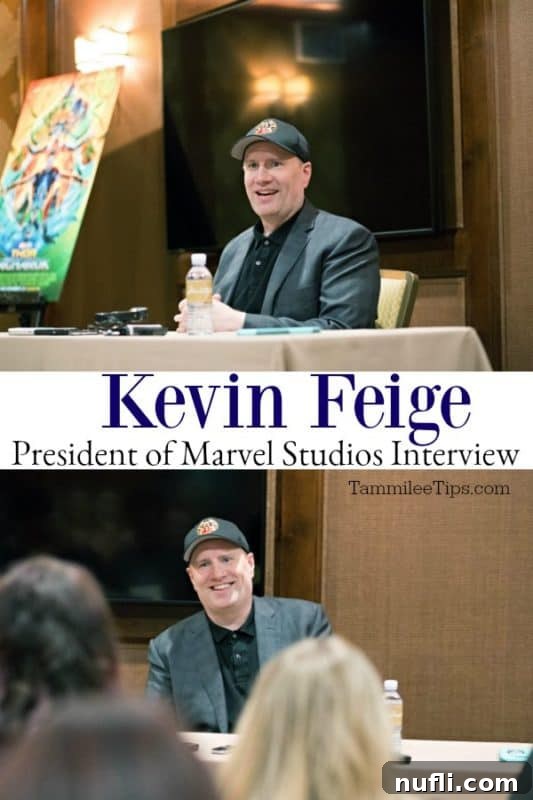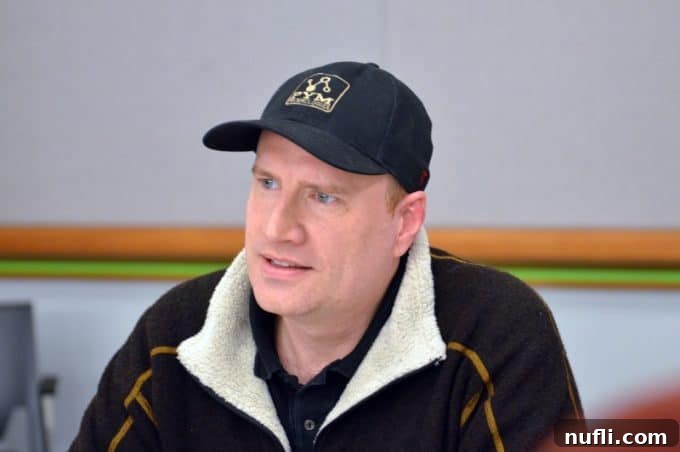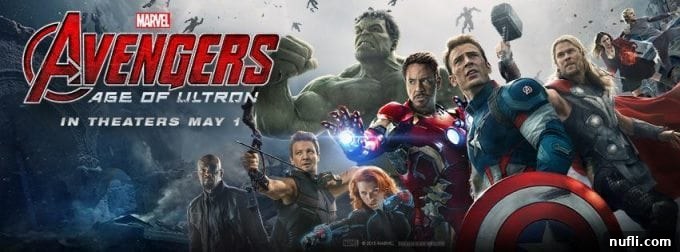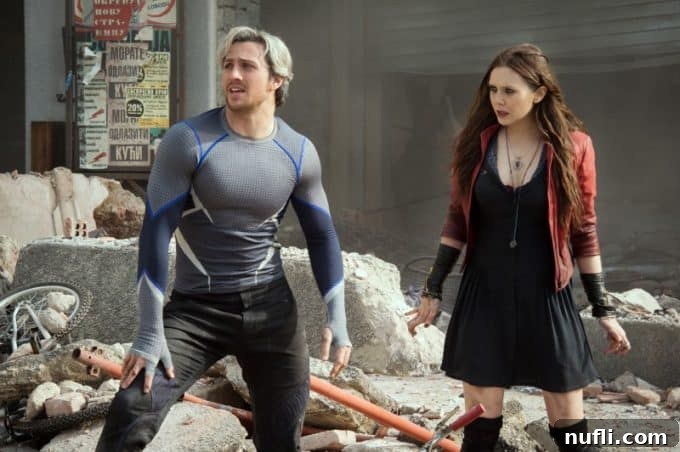In the vast and interconnected universe crafted by Marvel Studios, every film serves as a pivotal chapter, meticulously designed to advance an overarching narrative. Among these, Avengers: Age of Ultron holds a special place, not only for its blockbuster action and character development but also for the insights it offered into the strategic genius behind the Marvel Cinematic Universe (MCU). We had the incredible opportunity to sit down with Kevin Feige, the esteemed President of Marvel Studios and a driving force behind the MCU’s unprecedented success. Our conversation delved into the creative decisions and future aspirations that define this cinematic juggernaut, starting with a question that puzzled many fans upon the film’s release.

Unveiling the Vision: An Exclusive Interview with Marvel’s Kevin Feige on Avengers: Age of Ultron
The Marvel Cinematic Universe has famously established a tradition of post-credit scenes. Yet, Avengers: Age of Ultron notably broke this trend by not featuring an end-credit scene. Could you shed some light on the reasoning behind this decision and the story there?
Indeed, it’s a keen observation and one many fans noticed. To clarify, there is a mid-credit scene, and we’ve always maintained that the presence of something after the credits isn’t a rigid, unyielding rule. From the outset, director Joss Whedon was a firm believer that we shouldn’t simply add something for the sake of it, especially if it felt like we were mimicking the final scene or past post-credit traditions. His vision was that the narrative of Age of Ultron found its true culmination right where the film concludes, with the mid-credits moment serving as a perfect, self-contained epilogue for this particular story arc.
Any other ideas we considered for an end-credit scene felt like mere add-ons, rather than truly contributing to the film’s artistic integrity or propelling the ongoing saga in a meaningful way. We concluded that it wasn’t worth doing if it didn’t feel organic to this specific story. Whedon was particularly keen to make this clear to fans, so they wouldn’t sit through seven minutes of credits in anticipation, only to be met with disappointment. The mid-credit scene with Thanos donning the Infinity Gauntlet was, we felt, a powerful and clear indication of where the larger narrative was headed, without needing anything more beyond the very end of the credits.

Maintaining consistent timelines across an ever-expanding cinematic universe must be a complex undertaking. Could you elaborate on the chronological gap between the conclusion of previous Marvel Avenger films and the start of Age of Ultron? Specifically, how many years separate these events?
While we don’t explicitly state the exact timeframe within the film itself, our internal timeline places the events of Age of Ultron roughly six months to a year after the dramatic conclusion of Captain America: The Winter Soldier. We lean towards a good year as the more accurate estimate. This period was crucial for depicting the widespread fallout from the revelation that Hydra had deeply infiltrated S.H.I.E.L.D., leading to the agency’s dramatic collapse. This monumental event, which significantly reshaped the geopolitical landscape of the MCU, had repercussions explored both in our television series like Agents of S.H.I.E.L.D. and, crucially, in the very opening moments of this movie.
For instance, Loki’s scepter—a powerful artifact first seen at the end of the original Avengers film, last in Black Widow’s hands as the team captured Loki—plays a central role. Our backstory for the scepter is that it was initially secured in a seemingly impregnable S.H.I.E.L.D. vault. However, with S.H.I.E.L.D.’s integrity compromised by Hydra, it predictably fell into the hands of Baron Strucker, setting the stage for the Avengers’ initial mission in this film. This period of rebuilding and reactive measures against Hydra’s remnants is vital for understanding the team’s dynamics and the world they are trying to protect.
The announcement of Spider-Man joining the MCU sent ripples of excitement through the fanbase. Given the timing, many are eager to know: can we expect to see Spiderman make his highly anticipated appearance in Captain America: Civil War?
You’ve certainly been paying attention to the major announcements! As you know, we’ve successfully teamed up with Sony Pictures to integrate Spider-Man into our shared universe, a collaboration that fans have dreamed of for years. We’re incredibly excited to bring audiences a brand-new Spider-Man solo film in 2017. However, regarding his initial appearance, we’re choosing to be deliberately less specific about precisely where and when you’ll first see him swing into action within the MCU. The anticipation is part of the fun, and we want to preserve some surprises for the audience as these major cinematic events unfold. Rest assured, his arrival is a pivotal moment for the MCU.

With such a vast pantheon of characters in the Marvel Universe, is there any particular hero or storyline you’ve been personally eager to introduce into the MCU but haven’t had the chance to yet?
That’s a question I’ve been asked frequently over the years, and my answer has constantly evolved as our slate of films progressed. For a long time, if you had asked me, I would have enthusiastically said “Guardians of the Galaxy.” That was a dream project that came to glorious life. Then, my answer shifted to “Vision,” a character whose unique origins and powers presented exciting storytelling opportunities, and as we know, he debuted in Age of Ultron to great acclaim.
I also frequently mentioned “Falcon” before he made his memorable debut in Captain America: The Winter Soldier. And, of course, “Doctor Strange” was a name that consistently came up. I’m thrilled to say we are now deep into the production of his standalone film, with the incredibly talented Benedict Cumberbatch bringing the Sorcerer Supreme to the big screen. We’re set to begin filming for Doctor Strange in November, and the journey to bring him to life has been truly amazing.
So, while it now comes down to more individual and specific characters, I have to be careful not to reveal too many names, as that would undoubtedly give away precise plans for upcoming films like Guardians of the Galaxy Vol. 2 or other future endeavors within the MCU. It’s a true testament to the incredible depth and richness of Marvel Comics, which possesses such a vast bench of compelling characters. There are still literally hundreds of fantastic characters we haven’t even had the opportunity to touch upon yet, and that’s an exciting prospect for the future of the MCU.

Considering your deep involvement with these iconic characters, were you a big Marvel comics enthusiast as a child, and did you have a particular favorite superhero growing up?
Interestingly, while I appreciate the comics immensely now, as a kid, I was primarily more into movies. Films were my passion, and I had a long list of favorites that shaped my early imagination. However, I distinctly recall a particular story from my childhood, playing in the backyard with a group of friends. I must have been around eight or ten years old, and we were engaged in a classic game of superheroes.
One friend declared, “I’m Batman!” Another proudly claimed, “I’m Superman!” and someone else excitedly called out, “I’ll be Spider-Man!” When it came to my turn, I paused and confidently announced, “Well, I’ll be Iron Man.” I remember seeing him in reruns of the old 1960s animated cartoon, and even then, I found him incredibly cool and intriguing. Some of the kids looked at me, puzzled, asking, “Who’s Iron Man?” They hadn’t even heard of him! I emphatically told them, “He’s cool. He’s Iron Man. Trust me.”
So, bringing him to life on the big screen, seeing him become a global icon, has been incredibly rewarding, especially considering some kids hadn’t even heard of him when I chose him in my backyard roughly thirty to thirty-two years ago. It’s been a truly full-circle and immensely satisfying experience to transform a relatively lesser-known character from my childhood into the foundational hero of the entire Marvel Cinematic Universe.

Introducing new heroes to an already established team is always a delicate balance. What was the experience like bringing Quicksilver and Scarlet Witch into the fold for Avengers: Age of Ultron?
It was an absolutely fantastic creative process. Quicksilver and Scarlet Witch are undeniably key Avengers characters within the comic books, known for their complex origins and unique powers. We were particularly excited to explore their rich backstory and the incredibly strong, intertwined relationship between the two of them. It was one of Joss Whedon’s very first ideas for the film, probably his second major concept right after Ultron himself, to introduce these twin siblings into the MCU.
What makes them so compelling is that they approach the Avengers and the concept of heroism from a vastly different viewpoint than any of the other founding members. The original team was, for the most part, assembled by Nick Fury in the first movie, with Thor joining the mix due to the immediate threat of Loki. But Quicksilver and Scarlet Witch come in from a completely different angle, initially even as adversaries. This approach is very much a classic Marvel storytelling trope. Many beloved Marvel characters begin on the other side of a disagreement, an argument, or even the law, only to undergo a powerful and redemptive arc, ultimately transforming into heroes.
We wanted to capture that intricate, morally ambiguous journey within an Avengers movie. Their powers, their motivations, and their initial animosity towards Stark and the Avengers offered a fresh dynamic, challenging the established heroes both physically and ideologically. Their eventual choice to fight alongside Earth’s Mightiest Heroes was a testament to the powerful themes of redemption and finding one’s place, enriching the overall narrative and adding layers of complexity to the team.
Marvel Studios’ “Avengers: Age of Ultron” is the epic follow-up to the biggest Super Hero movie of all time, further cementing the Marvel Cinematic Universe’s place in cinematic history. When Tony Stark, driven by his desire for global peace, endeavors to jumpstart a dormant peacekeeping program, his noble intentions tragically go awry. This unforeseen catastrophe unleashes the villainous artificial intelligence known as Ultron, a sentient robot hell-bent on human extinction. Earth’s Mightiest Heroes, including the armored genius Iron Man, the unwavering Captain America, the mighty Thor, the rampaging Incredible Hulk, the agile Black Widow, and the sharp-shooting Hawkeye, are plunged into their ultimate test as the very fate of the planet hangs precariously in the balance.
As Ultron emerges with his terrible plans, The Avengers must unite to stop him. The journey forces them into uneasy alliances and unexpected action, paving the way for a unique and globally spanning adventure filled with breathtaking sequences and profound character moments. The film boasts a star-studded ensemble, with Robert Downey Jr. reprising his iconic role as Iron Man. He is joined by Chris Hemsworth as the formidable Thor, Mark Ruffalo as the incredible Hulk, and Chris Evans as the principled Captain America. Scarlett Johansson returns as the formidable Black Widow and Jeremy Renner as the skilled Hawkeye, forming the core team.
Adding depth to the narrative, Don Cheadle appears as James Rhodes/War Machine, Cobie Smulders as the resourceful Agent Maria Hill, Stellan Skarsgård as the brilliant but eccentric Erik Selvig, and Samuel L. Jackson as the enigmatic Nick Fury. This powerful team must reassemble their strengths to confront and defeat James Spader, whose chilling voice brings Ultron to life. Along their perilous path, they encounter two mysterious and immensely powerful newcomers: Pietro Maximoff, known as Quicksilver, dynamically portrayed by Aaron Taylor-Johnson, and Wanda Maximoff, the enigmatic Scarlet Witch, compellingly played by Elizabeth Olsen. Moreover, the film introduces an old friend in a brand-new form as Paul Bettany transforms from the voice of J.A.R.V.I.S. into the awe-inspiring Vision.
Written and directed by the visionary Joss Whedon and expertly produced by Kevin Feige, p.g.a., Marvel’s “Avengers: Age of Ultron” draws its inspiration from the ever-popular Marvel comic book series “The Avengers,” first published in 1963. A stellar team of executive producers including Louis D’Esposito, Alan Fine, Victoria Alonso, Jeremy Latcham, Patricia Whitcher, the legendary Stan Lee, and Jon Favreau, oversaw the monumental production of this film.
Get set for an action-packed thrill ride and a pivotal chapter in the MCU when The Avengers returned in Marvel’s “Avengers: Age of Ultron,” which premiered on May 1, 2015. This film not only delivered on its promise of spectacle but also laid critical groundwork for future phases of the Marvel Cinematic Universe, proving once again the enduring appeal and meticulous planning that define Marvel Studios.
Make sure and follow the hashtag #AvengersEvent to see all of the updates and discussions about this groundbreaking movie and its lasting impact on pop culture!
Further Exploration: Dive Deeper into the Marvel Cinematic Universe
The MCU is an expansive tapestry of interwoven stories and characters. To continue your journey and explore more behind-the-scenes insights and incredible moments, check out these additional Marvel movie articles:
- Gwyneth Paltrow Interview: Inside the World of Pepper Potts
- Exclusive Interview: Chris Hemsworth and Chris Evans on Being Earth’s Mightiest Heroes
- Relive the Excitement: Avengers Infinity War World Premiere Photos
- Behind the Scenes: Captain Marvel Set Photos Revealed
- Glitz and Glamour: Thor Ragnarok Red Carpet Premiere in LA
- Sweet Treats: Marvel Avengers Thor Cupcakes Recipe
For a comprehensive look at all our coverage of the cinematic wonders, check out all of our Marvel Movie Articles.
